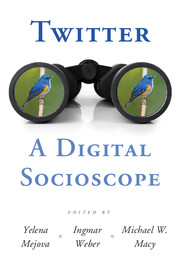5 - Public Health
Published online by Cambridge University Press: 05 May 2015
Summary
Twitter, crowdsourcing, and other medical technology inventions producing real-time geolocated streams of personalized data have changed the way we think about health (Kostkova 2015). However, Twitter's strength is its two-way communication nature – both as a health information source but also as a central hub for the creation and dissemination of media health coverage. Health authorities, insurance companies, marketing agencies, and individuals can leverage the availability of large datasets from Twitter to improve early warning services and preparedness, aid disease prevalence mapping, and provide personal targeted health advice, as well as influence public sentiment about major health interventions. However, despite the growing potential, there are still many challenges to address to develop robust and reliable systems integrating Twitter streams to real-world provision of healthcare.
Introduction
Health and well-being are top priorities for citizens, societies, and governments from individual to national and international levels. In particular, public health threats have become a focus due to globalization, the emergence of new diseases, and the reappearance of older infectious diseases. The SARS outbreak in 2003 illustrated how quickly a new virus could spread globally.
The growth of the Internet and social networks has enabled unprecedented support for individual health monitoring and personalized care, as well as large-scale public health measures (Smith & Christakis, 2008; Valente, 2010; Paul & Dredze, 2011). In particular, the role of Twitter in the health domain now encompasses a two-way channel for managing health and seeking health advice at the personal level on one hand, and for aiding early warning and out-break response systems with the aim of mobilizing knowledge and scientific expertise to protect populations on the other hand.
The spectrum of Twitter health research outreach is impressive. Paul and Drezde (2011) investigated how Twitter became an important medium for understanding concerns about public health, while Christakis and Fawler (2007, 2008) looked into the dynamics of health behavior on a large social network investigating smoking and obesity.
- Type
- Chapter
- Information
- Twitter: A Digital Socioscope , pp. 111 - 130Publisher: Cambridge University PressPrint publication year: 2015
References
- 4
- Cited by



